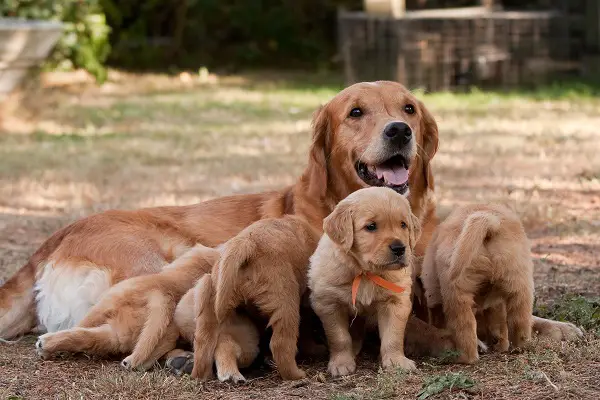Just like viviparous mammals, female dogs can carry their puppy fetuses in their womb until birth. Irrespective of the size or breed, the gestation process of dogs always begins with the internal fertilization of the mature eggs of the bitch. During the gestational period and until the birth of the puppies, many doubts and concerns are raised for the dog owners, who are mainly responsible for ensuring the welfare of the future mother and her litter is catered for.
Dog Estrous Cycle
In addition to breed, environmental conditions also influence the appearance of the first heat (some studies indicate that it occurs more often in spring or summer), as well as the presence of other females or the administration of medications. If the dog has not yet reached puberty at 18 months of age, the vet should be consulted to investigate the cause. It is normal for the first heat to appear between 7 and 10 months of age.
The heat period in dogs lasts about 15 to 18 days and usually occurs every 6 months, although there are breeds such as the German Shepherd that have shorter intervals. Dogs are monoestric, that is, they have a single sexual cycle per season of heat, in which single ovulation of several eggs occurs. Ovulation is spontaneous since it occurs whether the dog is mounted or not, contrary to what happens for example in the cat which does not ovulate if it is not mounted.
The estrous cycle in dogs consists of four phases namely: Proestrus, Estrus, Diestrus and Anestrus.
- Proestrus: The first stage of the cycle is the proestrus. The most obvious sign of the onset of heat occurs during this phase; that is, bleeding from the vul.va, which lasts about 9 to 11 days. In this phase, there is swelling of the vul.va, the bitch urinates more frequently and attract males, but do not allow riding. Several bitches living together will tend to synchronize their cycles due to the effect of pheromones.
- Estrus: The second phase of the cycle is called the estrus and it usually lasts between 5 and 9 days; although it can vary between 3 and 21 days. It begins when the dog allows mounting and ends when she rejects it. One sign that the dog is ready to accept the male (sexually receptive) is that it pulls its tail to one side when pressed on its back. During estrus, the vul.va takes on a more swollen appearance and the vagin.al discharge is reduced, taking on a brownish hue, not as bloody as before. Once estrus has started, ovulation usually occurs within two days. Within the estrus, the metaestrus takes place, a period of 3-5 days in which the ovaries begin to prepare to maintain a possible pregnancy. The changes that the animal undergoes during the first two phases of the estrous cycle produce a series of inconveniences for the owners: bloody vagin.al discharges stain the house, and the increased frequency of urination sometimes causes incontinence. It is also common to observe a decrease in the bitch’s appetite and a slight increase in physical activity.
- Diestrus: When the bitch refuses to ride again, it is a sign that the heat has ended, beginning the diestrus phase. This phase lasts for about 60 to 90 days, in which the bloody flow stops (mucus may appear), the vul.va reduces its inflammation and recovers its usual appearance.
- Anestrus: The subsequent period of sexual inactivity is the anestrus, and it persists until the next proestrus.
Do Female Dogs Menstruate?
No, female dogs don’t menstruate. A woman’s menstruation occurs at the end of the menstrual cycle only if she is not pregnant. The elimination of blood occurs along with remains of the walls of the uterus, which had been prepared to accommodate a possible pregnancy that, in the end, has not taken place. The bleeding of the female dog or bitch, on the contrary, indicates the beginning of the estrous cycle. It is thought to be caused by an increase in uterine blood supply, and it happens regardless of whether there will be a pregnancy or not.
Dog Gestation Period
How Long is a Dog Pregnant?
The gestation period in dogs is between 63 and 65 days from the first day of mating. Dogs have an average gestation period of 64 days.
☛ Check This Out: Dog Gestation Calculator and Chart
The gestation period in dogs is often determined by various factors such as the care the mother has had, the characteristics of the breed and the individual, the size of the litter, the family average, among others. As a general rule, a pregnancy that brings a large litter should trigger labor earlier than another of a small litter. This is because the puppies occupy more space in the uterus and the mother’s body suffers more wear in the last stage of gestation. The body size of the mother’s breed also influences the term of the pregnancy, with the small breeds more likely to have long pregnancies, while the larger breeds are generally shorter.
Since there is no need to worry if the puppies are delayed a little, as long as the gestation period is in the specified average range. If the bitch did not whelp after 68 days, then a veterinarian should be consulted quickly, since this is the deadline for a normal canine pregnancy. It may be necessary to induce labor or perform a caesarean section.
On the other hand, before day 58, premature birth is considered and puppies have a high risk of death in the first days of their life if they are not already dead. Generally, the litter needs a few more days in the uterus to finish developing its lungs and to have a chance of survival.
Dog Pregnancy
Planning
It is always good that the pregnancy of dogs is responsibly planned by the dog owner. This is primarily to prevent complications during pregnancy or giving birth to unwanted pups. So once a dog owner has decided to breed the bitch, they must ensure that she is completely healthy, and that she has been previously dewormed and vaccinated. If pregnancy occurs accidentally, it will be necessary to wait for the puppies to be weaned to be able to vaccinate the mother. It is important to note that a pregnant dog can be dewormed between 30 and 45 days of being pregnant.

Signs of Pregnancy in Dogs
New dog owners might find it hard to tell whether their dogs are pregnant or not. No doubt, some changes occur inside and outside the body of pregnant dogs, and these changes are clues that a dog may be pregnant. Some of the signs that show that a dog might be pregnant are described as follows:
- Loss of appetite. A pregnant dog may start showing a lack of interest in food during the first few weeks of pregnancy. This, however, does not happen in some dogs. Loss of appetite is often referred to as the ‘morning sickness in dogs.’ If you noticed that your dog lacks the zeal to eat, it is vital to avoid forcing her to eat. She will eat whenever the appetite returns, which usually doesn’t take too long. Kindly note that if your dog refuses to eat for many days, contact your vet as soon as possible. The dog needs to be examined to know what could be wrong.
- Changes in behaviors. Pregnant dogs also experience behavioral changes like pregnant women. The behavioral changes are not the same in all dogs. You may see your dog become easily irritated and preferring to be left alone. She may suddenly become very needy, crave your affection and attention. Whatever the case may be for your dog, you must always cope with the behavioral changes as best as you can. Whenever she is irritated, you should leave her and don’t allow people or other pets to go near her. And when she needs your attention and affection, endeavor to give her, and you can massage her body and brush her furs.
- Obvious changes in the body. When a dog is pregnant, don’t be surprised to see some changes in certain body parts. These include swelling and increment of the dog’s nipple size, a slight change in the nipples’ color, an increase in body weight, and vagin.al discharges. The changes in the nipples occur in preparation for imminent milk production. At the same time, the bitch will become heavier due to the fetuses developing inside her.
- Loss of energy. Fatigue or tiredness is another sign of pregnancy in dogs. You shouldn’t be too scared when you see your lively, energetic dog suddenly become fatigued and uninterested in activities. This happened because she may be pregnant. However, it is imperative to decide if the loss of energy is due to puppies growing inside the dog’s womb, or the dog is sick. If you notice other signs and symptoms of illness together with the lethargic disposition, don’t hesitate to consult your vet.
Normally, the first twenty days of gestation of a dog pass normally, without evident symptoms. To confirm the state of pregnancy, it is necessary to wait between 25 and 30 days, at which time a diagnostic ultrasound can be performed and the general state of the embryos can be known. If earlier confirmation is desired, an X-ray can be chosen around 6 weeks after mounting, with which the number of puppies in the litter can be known.
Once the pregnancy of a dog is confirmed, it is necessary to make a change to the diet in order to ensure good fetal development. It is ideal to do so since she has mated with a male.
Veterinary check-ups during pregnancy are important. In addition to checking that puppies are growing as expected, problems with pregnancy can be diagnosed early. If there is a form of bleeding from the bitch’s vul.va, the attention of the vet should be drawn or contacted immediately because it may be the indicator of a miscarriage.
Some symptoms that may indicate that the mother-to-be is close to the moment of delivery are a drop in body temperature, the start of milk production and changes in her habitual behavior (she can be restless and seclude herself in quiet and dark places).
Dog Whelping
Whelping is the process of giving birth to puppies in dogs. As with humans and other animals, the act of labor and birth of puppies must go normally. Therefore, specialized interventions are rarely required. A normal whelping can take between 12 and 24 hours, although in first-time bitches, it can take up to 36 hours.
Ideally, the dog will give birth to her puppies in a familiar and calm environment, without too many looks or interruptions; otherwise the natural birth process may be delayed. She will instinctively know what to do. The owner or vet can only be a watcher of her efforts to give birth and observing if there are any complications in the birth of the pups.
Signs of Labor in Dogs
The following are some signs or clues that a dog is about to go into labor.
- Restlessness
- Whining
- Moaning
- Rejection of water and food
- Frequent urination
- Frequent vomiting
- Panting
- Shivering
- Digging around the whelping box
Stages of Labor in Dogs
The birth of a dog normally consists of three phases.
- The first phase is preparatory, the cervix relaxes and dilates to allow the puppies to exit through the canal, and some uterine contractions, although weak, may also appear.
- The second phase is decisive as the bitch’s efforts to push out the puppies begin. She lies on one side and begins to have more intense and frequent contractions, while pushing hard towards the back end of her body. There is no pattern for birth and puppies can be born every 15 minutes or even hours. If not a single pup has been born after 8 hours of labor with contractions, then it is advisable to call a vet.
- The third and last phase is the one that corresponds to the exit of the placentas.
When labor does not occur naturally due to complications or too long a pregnancy, then a cesarean section will be necessary. The reasons for a dystocic delivery are generally of maternal origin, such as being overweight, a poor diet during pregnancy or a very old age. Although the excessive size of the puppies and their bad placement in the pelvic canal can also be reasons for a cesarean section.
Litter Size in Dogs
At the end of a dog’s gestation, multiple pups can be born. An average litter can have six pups, although this number can rise to 12 or decrease to 2, depending on the size of the breed and whether it is a first-time mother or not. Large dog breeds generally have quite large offspring, with an average of 8 to 12 puppies per litter, while small breeds are characterized by smaller litter size that do not exceed 4 puppies.
Postpartum
A few days after whelping, a dog may continue to expel remnants of blood. This will occur until her genitourinary system returns to normal. Do not be scared to see the mother dog ingesting the remains of the placentas and the umbilical cords of her puppies. This is a totally normal behavior since she herself is in charge of cleaning them and stimulating their breathing through continuous licks.
In order to avoid the loss of any of the puppies during the first hours of life, it is always convenient to prepare a warm place covered with blankets, so that the new mother spends the night with her puppies. Ensure that there is enough room for the bitch to lie down comfortably to feed all her newborn puppies.



